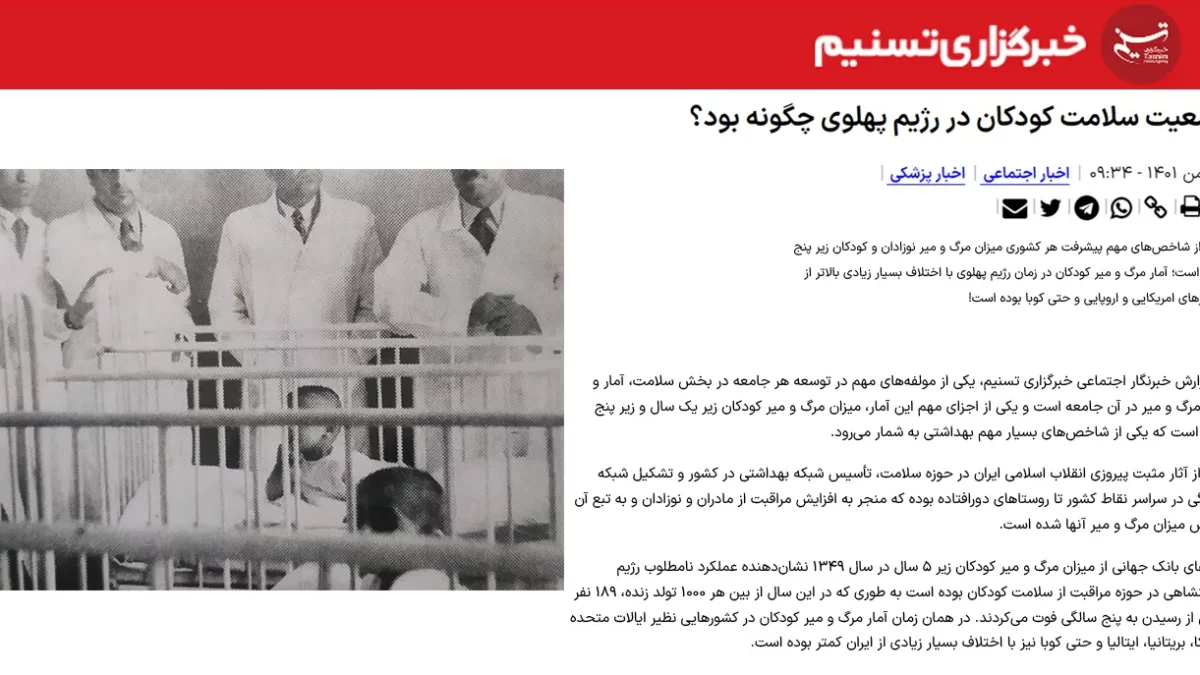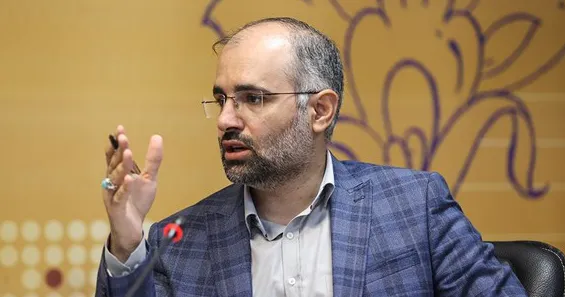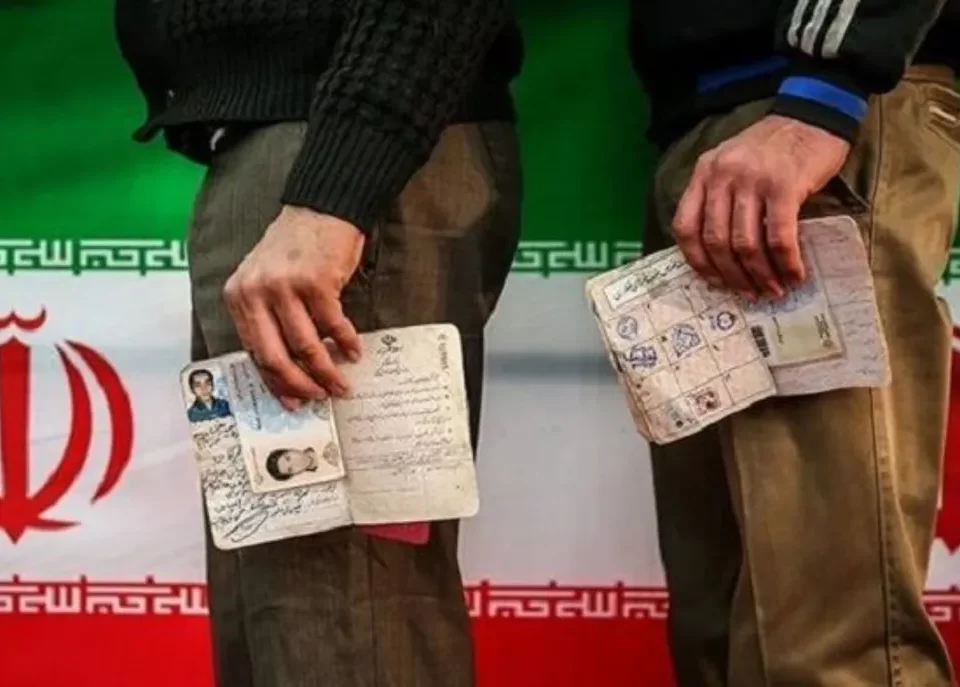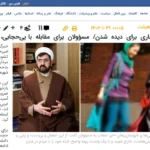
Media Review: Fars News Agency’s False Claims to Promote Hijab
May 6, 2023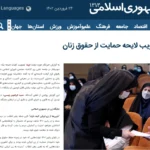
Media Review: IRNA and the Deceptive Anti-Women Government of Raisi
May 7, 2023Have you ever thought about how the media shapes our mentality towards issues and to what extent the images they depict of events are close to reality or encompass a certain level of truth?
Content framing is a media tactic that enables journalists to select aspects of reality that align with the knowledge, beliefs, and perspectives of the audience, and present audience-friendly content. For this reason, media outlets pay attention to the beliefs and values of their audience when framing content.
Therefore, it can be said that the framing of news and information varies in each media outlet because each outlet has a different audience. However, audiences are usually unaware of the role and impact of content framing in shaping their beliefs, and they pay less attention to the literature and language used by journalists, which significantly influences their interpretation and understanding of information.
Information framing becomes problematic when a journalist presents false and inaccurate information or biased choices of events as the whole truth to the audience, intentionally or unintentionally misleading them.
To clarify the issue, let’s look at this report by Tasnim News Agency, published on 17 Bahman 1401 (February 6, 2023), titled “What was the state of children’s health in the Pahlavi regime?”.
In this report, the Tasnim journalist compares the mortality statistics of children under five years of age in 1345 (1966-1967) and 1401 (2022-2023) and writes in the introduction: “One of the important components of development in any society in the health sector is the statistics and causes of mortality in that society. One of the significant parts of these statistics is the mortality rate of children under one year and under five years, which is considered a crucial health indicator. One of the positive effects of the victory of the Islamic Revolution in Iran in the health sector has been the establishment of a health network in the country and the formation of a monitoring network throughout the country, even in remote villages, which has led to increased care for mothers and infants and, consequently, a reduction in their mortality rate.”
The journalist continues: “World Bank statistics on the mortality rate of children under five in 1349 (1970-1971) indicate the unfavorable performance of the Shah’s regime in the field of child health care, to the extent that in that year, out of every thousand live births, 189 individuals died before reaching the age of five. At the same time, the mortality rate of children in countries such as the United States, the United Kingdom, Italy, and even Cuba was significantly lower than that of Iran.”
This report concludes as follows to the audience: “In the years 1350 to 1355, the infant mortality rate per thousand population was 164. This rate had decreased to 25 in the years 1385 to 1390 and has now reached 11 per thousand population, indicating a reduction of about 15 times in the infant mortality rate after the victory of the revolution.”
Framing information in a way that is based on news values and impartiality is a professional act, but when it is done with the aim of shaping public opinion and deceiving the audience, it is neither professional nor ethical.
In a comparative study of an event between several countries, it is not possible to select the development trend of a poor country with a wealthy country or a developed country with a developing country and expect realistic results.
Tasnim News Agency, instead of comparing the health situation in Iran with countries that had similar per capita income, population, geographical location, etc., compared the under-five child mortality rate in Iran in 1349 with the under-five child mortality rate in the United States, Britain, Italy, and Cuba. This news agency considered the existing gap between Iran and those countries in that year, and the decrease in the distance between them in 1401, as a sign of Iran’s progress during the period of the Islamic Republic. While the manipulative and deceptive manner of presenting information has become evident.
However, if Tasnim News Agency’s approach had been impartial, sincere, and scientific, more accurate results would have been obtained. It is enough to include the names of some neighboring and Middle Eastern countries that had a similar income, population, and geographical situation to Iran in 1349 in the comparative study and see the differences in the results. For example, compare Iran in 1349 with Saudi Arabia, Turkey, and Oman to see that Iran has not only been less successful than these countries in reducing the under-five child mortality rate over the past 50 years but they also have slightly better conditions. Although the overall situation of under-five child mortality in Iran had significant similarities to these countries in both 1349 and 1401.
For example, the status of under-five child mortality rates among some of the neighboring and regional countries, including Turkey, Saudi Arabia, Oman, and Pakistan, has been examined, and the results are shown in the chart and table below:
The selected countries in the above chart are only a comparison between Iran and surrounding countries. Naturally, if we want to have a scientific comparative study, we should first accurately extract the list of countries that can be compared with Iran, and then compare their progress or regress in a specific time frame. That means we should say in which category Iran was placed in 1349 compared to which country in the region and the world, then see how the progress of these countries has been over the past 50 years and which successes they have achieved.
So when dealing with media productions, we should always be aware of the mechanism of framing information to know how much we are facing the truth. The public’s reaction to an event is usually the result of framing information, but if the audience is aware of the tactics of framing information, the public’s reaction to the news can be different.
Acquiring an understanding of how information is framed for media audiences is not an easy task, but at the very least, we can refrain from blindly trusting the media and strive to obtain information from multiple sources. With this action, over time, we can become aware of how information is framed by each media outlet and also assess the credibility of their information by looking at how they frame the information they provide.
مرور رسانهها؛ خبرگزاری تسنیم و برخورد فریبکارانه با اطلاعات و آمار
تاکنون به این مهم فکر کردهاید که رسانهها چهگونه ذهنیت ما را نسبت به مسایل شکل میدهند و چهقدر تصویری که از رویدادها برای مخاطب ترسیم میکنند، با واقعیت نزدیک یا دربرگیرنده چه میزانی از واقعیت است؟
فریمبندی محتوا، تاکتیکی رسانهای است که خبرنگاران را قادر میسازد تا جنبههایی از واقعیت که با دانش، عقاید و نگرشهای موجود مخاطب ارتباط برقرار میکنند را برگزیند و محتوایی مخاطبپسند ارایه کنند. به همین دلیل رسانهها در فریمبندی محتوا، به باورها و ارزشهای مخاطبان خود توجه دارند.
پس میتوان گفت فریمبندی اخبار و اطلاعات در هر رسانه متفاوت است، چرا که هر رسانه، مخاطبی متفاوت دارد. اما مخاطبان معمولا متوجه نقش و تاثیر فریمبندی محتوا در شکلدهی به باورهای آنها نیستند و کمتر به این مهم توجه دارند که ادبیات و زبانی که خبرنگاران به کار میبرند، در تفسیر و فهم آنها از اطلاعات موثر است.
فریمبندی اطلاعات زمانی مسالهساز میشود که خبرنگار اطلاعات جعلی و نادرست یا انتخابهای جانبدارانه خود از وقایع را به عنوان تمام حقیقت به مخاطب عرضه میکند و عامدانه یا ناآگاهانه مخاطب را گمراه میسازد.
برای روشن شدن مساله، به این گزارش خبرگزاری «تسنیم» که روز ۱۷ بهمن ۱۴۰۱ با عنوان «وضعیت سلامت کودکان در رژیم پهلوی چهگونه بود؟» شد، نگاه کنید.
خبرنگار تسنیم در این گزارش به مقایسه آمار مرگ و میر کودکان زیر پنج سال در سال ۱۳۴۵ و ۱۴۰۱ پرداخته و در مقدمه نوشته است: «یکی از مولفههای مهم در توسعه هر جامعه در بخش سلامت، آمار و علل مرگ و میر در آن جامعه است و یکی از اجزای مهم این آمار، میزان مرگ و میر کودکان زیر یک سال و زیر پنج سال است که یکی از شاخصهای بسیار مهم بهداشتی به شمار میرود. یکی از آثار مثبت پیروزی انقلاب اسلامی ایران در حوزه سلامت، تاسیس شبکه بهداشتی در کشور و تشکیل شبکه مویرگی در سراسر نقاط کشور تا روستاهای دورافتاده بوده که منجر به افزایش مراقبت از مادران و نوزادان و به تبع آن، کاهش میزان مرگ و میر آنها شده است.»
او در ادامه آورده است: «آمارهای بانک جهانی از میزان مرگ و میر کودکان زیر پنج سال در سال ۱۳۴۹ نشان دهنده عملکرد نامطلوب رژیم شاهنشاهی در حوزه مراقبت از سلامت کودکان بوده است، به طوری که در این سال از بین هر هزار تولد زنده، ۱۸۹ نفر پیش از رسیدن به پنج سالگی فوت میکردند. در همان زمان، آمار مرگ و میر کودکان در کشورهایی نظیر ایالات متحده امریکا، بریتانیا، ایتالیا و حتی کوبا نیز با اختلاف بسیار زیادی از ایران، کمتر بوده است.»
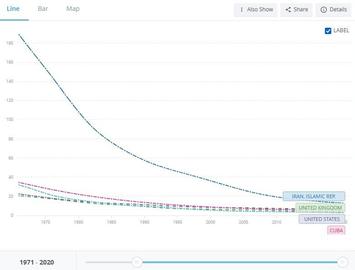
این گزارش در نهایت جمعبندی خود را این گونه به مخاطب عرضه کرده است: «در سالهای ۱۳۵۰ تا ۱۳۵۵، میزان مرگ و میر کودکان زیر یک سال در هر هزار نفر جمعیت، ۱۶۴ نفر بوده است. این آمار در سال ۱۳۸۵ تا ۱۳۹۰ به ۲۵ نفر رسیده بود و اکنون به ۱۱ نفر در هر هزار نفر جمعیت رسیده که حاکی از کاهش حدود ۱۵ برابری نرخ مرگ و میر کودکان زیر یک سال، پس از پیروزی انقلاب است.»
فریمبندی اطلاعات زمانی که براساس ارزشهای خبری و بیطرفانه شکل میگیرد، اقدامی حرفهای است اما زمانی که با هدف شکلدهی به افکار عمومی و فریب مخاطب انجام میشود، دیگر نه حرفهای و نه اخلاقی است.
در یک مطالعه تطبیقی از یک رویداد بین چند کشور، نمیتوان روند توسعه یک کشور فقیر با یک کشور ثروتمند یا یک کشور توسعه یافته با یک کشور در حال توسعه را انتخاب کرد و انتظار داشت که نتایج واقعبینانهای حاصل شود.
خبرگزاری تسنیم به جای تطابق وضعیت سلامت در ایران و کشورهایی که به لحاظ سرانه درآمدی، جمعیت، موقعیت جغرافیایی و… در موقعیتی شبیه به ایران قرار داشتهاند، آمار مرگ و میر کودکان زیر پنج سال در ایران در سال ۱۳۴۹ را با آمار مرگ و میر کودکان زیر پنج سال امریکا، بریتانیا، ایتالیا و کوبا مقایسه کرده است. این خبرگزاری شکاف موجود میان ایران در آن سال را با این کشورها و کم شدن فاصلهها با آنها در سال ۱۴۰۱، نشانه پیشرفت ایران در دوره جمهوری اسلامی دانسته است. در حالی که شیوه دستچین کردن جانبدارانه و فریبکارانه اطلاعات، نخنما شده است.
حال آنکه اگر برخورد خبرگزاری تسنیم بیطرفانه، صادقانه و علمی بود، نتایج دقیقتری حاصل میشد. فقط کافی است به جای امریکا، بریتانیا، ایتالیا و کوبا که هیچ نسبتی با ایران نداشته و ندارند، اسامی تعدادی از کشورهای همسایه و منطقه خاورمیانه که در سال ۱۳۴۹ وضعیت درآمدی، جمعیتی و جغرافیایی مشابهتری به ایران داشتهاند را در مطالعه تطبیقی وارد کنید و تفاوت در نتایج را ببینید؛ برای مثال، ایرانِ سال ۱۳۴۹ را با عربستان، ترکیه و عمان مقایسه کنید تا ببینید که ایران در طول ۵۰ سال گذشته در کاهش مرگ و میر کودکان زیر پنج سال نه تنها موفقتر از این کشورها عمل نکرده بلکه آنها کمی اوضاع بهتری دارند، هرچند در مجموع وضعیت مرگ و میر کودکان زیر پنج سال در ایران، هم در سال ۱۳۴۹ و هم در سال ۱۴۰۱، شباهت زیادی به این کشورها داشته و دارد.
برای نمونه، به وضعیت آمار مرگ و میر کودکان زیر پنج سال در میان تعدادی از کشورهای منطقه و همسایه ایران، از جمله ترکیه، عربستان، عمان و پاکستان پرداخته شده که نتایج آن در نمودار و جدول زیر نمایان است:
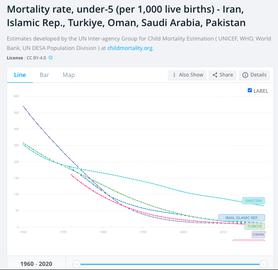
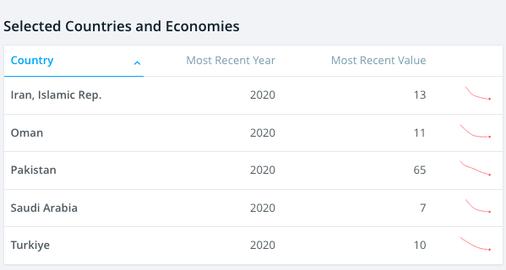
کشورهای انتخابی نمودار بالا، تنها مقایسهای است میان ایران و کشورهای پیرامونی. طبیعتا اگر بخواهیم یک مطالعه تطبیقی علمی داشته باشیم، باید اول فهرست کشورهایی که قابل مقایسه با ایران هستند را دقیق استخراج و سپس میزان پیشرفت یا پسرفت آنها را در یک پروسه زمانی مشخص مقایسه کنیم؛ یعنی بگوییم ایران در سال ۱۳۴۹ با کدام کشور در منطقه و جهان در یک کتگوری میگنجیده است، سپس ببینیم در طول ۵۰ سال گذشته روند پیشرفت این کشورها چهگونه بوده است و کدام موفقیتهای بیشتری کسب کردهاند.
پس در برخورد با تولیدات رسانهای، همواره باید به مکانیزم فریمبندی اطلاعات آگاه باشیم تا بدانیم چهقدر با حقیقت مواجه هستیم. واکنش عمومی نسبت به یک واقعه معمولا نتیجه فریمبندی اطلاعات است، حال آن که اگر مخاطبان با تاکتیک فریمبندی اطلاعات آگاه باشند، واکنش عمومی به اخبار میتواند متفاوت باشد.
آگاهی یافتن به نحوه فریمبندی اطلاعات برای مخاطبان رسانهها کار سادهای نیست ولی حداقل کاری که میتوان کرد، این است که به سادگی به رسانهها اعتماد نکنیم و بکوشیم اطلاعات را از منابع متعدد دریافت کنیم. با این اقدام، به مرور هم میتوان به نحوه فریمبندی اطلاعات توسط هر رسانه آگاه شد و هم به میزان صداقت رسانهها پی برد و در ارزیابی میزان اعتبار آنها، به نحوه فریمبندی اطلاعاتی که عرضه میکنند نگاه کرد.

